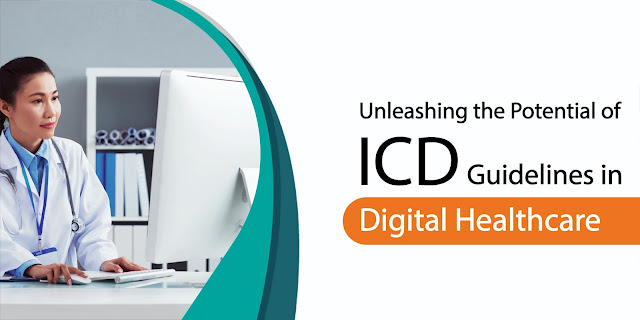In the ever-evolving landscape of the healthcare sector, the convergence of digital healthcare and healthcare software has revolutionized the approach to patient care and administration. As medical diagnoses and procedures become more complex, the need for a standardized coding system is crucial in order to streamline healthcare practices. The International Classification of Diseases (ICD) guidelines offer a comprehensive framework for precisely documenting and coding medical information. In this blog, let’s explore the essence of ICD guidelines, the significance of adhering to them, and the advantages that arise from their implementation in the healthcare industry.
Understanding ICD guidelines
The ICD or International Classification of Diseases guidelines, formulated by the WHO, are globally acknowledged and standardized classification principles. They act as a universal language within the healthcare industry, enabling seamless communication and data interchange among healthcare providers, insurers, and researchers worldwide. This system consists of a comprehensive catalog of diagnostic codes that classify diseases, symptoms, abnormal findings, external causes of injury, and various other health-related conditions. Through the assignment of distinct codes to each condition or procedure, ICD ensures precise documentation and facilitates thorough record-keeping and data analysis. These guidelines play a crucial role while developing healthcare software.
The importance of following ICD guidelines
Accurate Documentation - Consistent and comprehensive documentation of medical information is ensured through the implementation of ICD guidelines. Adhering to this empowers healthcare professionals to precisely describe a patient’s condition, fostering improved communication and care continuity among different providers. This not only enhances patient outcomes but also reduces the risk of medical errors.
Streamlined Billing and Reimbursement - The proper application of ICD guidelines is vital for healthcare organizations to receive appropriate reimbursement for their services. Insurance companies rely on these codes to determine coverage and reimbursement rates for specific diagnoses and procedures. By meticulously documenting and coding medical information, healthcare providers can minimize claim denials and ensure prompt payments, streamlining the billing and reimbursement process.
Improved Research and Population Health Analysis - The standardized coding system offered by ICD simplify the aggregation and analysis of healthcare data. Researchers and public health agencies can leverage this data to identify disease patterns, evaluate treatment effectiveness and develop targeted interventions. The availability of reliable and comprehensive data supports evidence-based decision-making, leading to advancements in medical research and ultimately improving population health outcomes.
Benefits of following ICD guidelines

Enhanced Patient Safety - The implementation of ICD guidelines plays a pivotal role in promoting patient safety through accurate identification and documentation of medical conditions. This precision significantly reduces the risk of misdiagnosis and inappropriate treatment, ultimately leading to improved patient outcomes and satisfaction. Furthermore, the standardized coding system facilitates the detection of potential adverse events and enables the implementation of preventive measures.
Interoperability and Information Exchange - This code enables seamless interoperability and information exchange for healthcare software, facilitating the sharing of critical patient data, including medical history, diagnoses, and treatments. This enhances care coordination and continuity, especially during care transitions.
Efficient Population Health Management - This guideline aid in population health management by providing accurate data on disease prevalence and distribution, which helps public health agencies to identify high-risk populations, develop targeted interventions, and allocate resources effectively. Also, healthcare organizations can implement preventive strategies and enhance overall population health.
Enhanced Clinical Decision-Making - The ICD guidelines classify diseases, symptoms, and procedures, aiding healthcare providers in making informed clinical decisions. The standardized coding system provides comprehensive patient information, ensuring accurate diagnoses and suitable treatment plans. This fosters evidence-based medicine and enhances overall patient care.
Efficient Healthcare Resource Allocation - Accurate documentation and coding according to the ICD guidelines provide valuable insights into healthcare utilization. This data helps identify high-demand areas, allocate resources effectively, and optimize healthcare delivery. It contributes to cost management, waste reduction, and targeted resource allocation.
Support for Health Information Exchange - Accurate documentation and coding according to ICD guidelines provide valuable insights into healthcare utilization. This data helps identify high-demand areas, allocate resources effectively, and optimize healthcare delivery. It contributes to cost management, waste reduction, and targeted resource allocation.
Compliance with Regulatory Requirements - ICD guidelines are mandated in many countries to ensure standardized coding practices for
digital healthcare developments. Compliance is crucial to avoid penalties and legal issues, ensuring data integrity and upholding the quality of care.
International Compatibility - ICD globally recognized classification system used by healthcare organizations worldwide. Standardized codes promote international collaboration, research, and data comparison. They enable global information sharing, advancing medical knowledge, treatment protocols, and global health initiatives.
In conclusion, incorporating ICD guidelines in digital healthcare is vital. Optimize patient care and streamline processes by embracing the power of ICD. Upgrade your digital healthcare systems today for improved outcomes.





Comments
Post a Comment